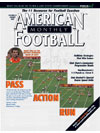AMERICAN FOOTBALL MONTHLY THE #1 RESOURCE FOR FOOTBALL COACHES
Article CategoriesAFM Magazine
|
Linebacker Keys in Read Progressionby: Michael Parker© More from this issue Since the early days of the conference, the WAC has been known as a place where creative coaches experiment and become pioneers in various aspects of offense. And with teams like Boise State, Hawaii, Nevada and New Mexico State, not much has changed in that regard. Enter Mark Johnson, the Defensive Coordinator for Utah State’s Aggies. Two seasons ago, Johnson brought his unique defense to Logan, and has begun the process of building the Aggies into a defense that can match the offensive firepower of the offensive-minded members of the conference. Football is a Simple Game Football is a simple game to Mark Johnson. And he strives to make it simple for his LBs. “At all levels of football as LB coaches we teach our players basic techniques: tackling, block protection, zone drops, man coverage, blitz and pass r....The full article can only be seen by subscribers. Subscribe today!
|
|
|||||||
| HOME |
MAGAZINE |
SUBSCRIBE | ONLINE COLUMNISTS | COACHING VIDEOS |
Copyright 2025, AmericanFootballMonthly.com
All Rights Reserved





